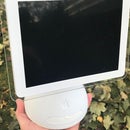Introduction: Solar George Foreman Cooker
Following the success of my 4ft solar cooker, I wanted to go larger. Finding a rigid satellite larger than 4ft can get very expensive, as you won't likely find one for free. I searched Craigslist and eBay, but nothing affordable came along. I had posted a picture of my 4ft dish on Facebook, and a cousin of mine texted me that he had some more satellite dishes in his back yard.
Step 1: What Is It?
I took a trailer over to my cousin's house and picked up 4 cages of satellite dish quarters. Each cage has two quarters of a dish mounted to the cage. The label on the cage is AS-554/TRC-29. This is a military nomenclature. Some google searches found that the TRC-29 is a microwave radio, and the AS-554 is the antenna from the 1950's. These are 'expanded metal' or mesh dishes made of Aluminum. I now had to engineer a way to set it up to be easily moveable to point at the sun.
Step 2: Dream a Little Dream...
Most terrestrial satellite dishes are setup to pivot right around the center of the dish. This means that I would have to have a mount about 5ft tall to support an 8ft dish. There would be a lot of stress on the linkages using this type of setup while still making it mobile or portable. My first ideas were to have a curved cage to keep onlookers at bay while having three legs to support the center mast. Not having a roller bender, I would be unable to build such a mount. I thought about alternatives, and finally settled on a giant lazy Susan style base and only using 3/4 of the dish.
Step 3: Gather Resources.
Again I collected old/bad hard drives. Disassembling them all, I saved the platters for reflective material and the NEO magnets for other projects. This dish would require approximately 400+ platters.
Step 4: Testing the Mount
I purchased a few long pieces of 1.5x1.5 box tubing, some end caps, and some sliding pin locks. I used an arc welder to stick weld together the frame. I designed the four wheels to have pivot points so that in one position, the wheels are aligned in parallel so it will roll as a trailer. In the other position (45 degrees off), it will rotate in place. I assembled three pieces of dish, added a pivot point to each side near the center of balance so it would be easier to position.
Step 5: Get the Most Coverage
I spent some time laying out the best way to have the most coverage with the least amount of gaps. After several iterations, I settled on a design. I then started gluing on the platters with standard white tub caulk. Two dabs, and then flatten the back side with a putty knife to ensure the coverage sticks (the photo is from another dish with finer mesh, but the affect is the same).
Step 6: Get Sunny
I purchased a used George Foreman grill from Goodwill. I managed to attach it to the dish with a couple arms so that it was near the focal point. The first photo is on a rainy day (see the rain drops?), the second photo is from a sunny day. I put a couple burgers and brats on it. Temps held steady at 350 degrees F. The reason it did not get hotter is the curvature of the dish is not as accurate as my previous 4ft solid dish, so the focal area of solar concentration is a lot larger. Short shaky video of the meat smoking!
Step 7: Next Time...
Dream a little bigger... I found a 12ft mesh dish that will require 1100 hard drive platters...













